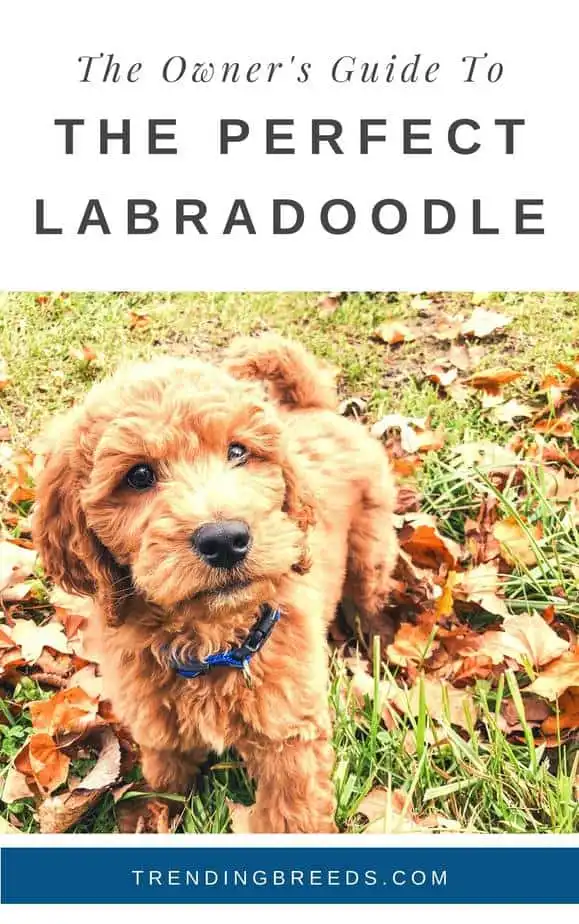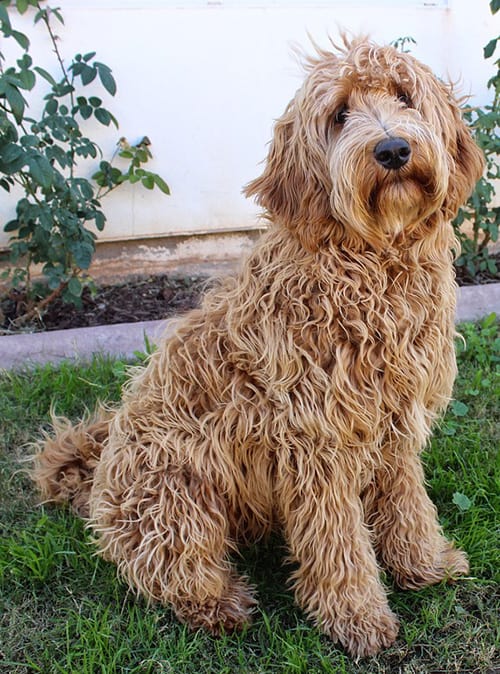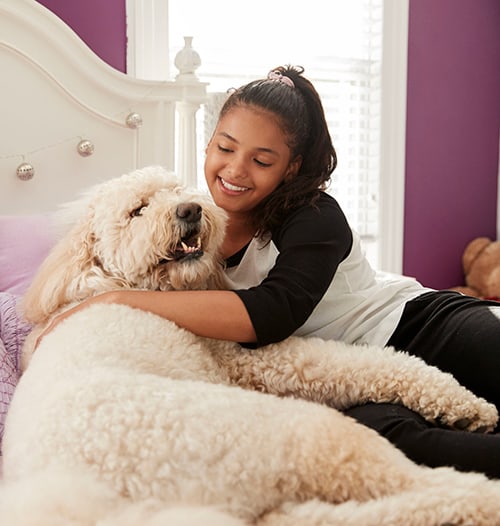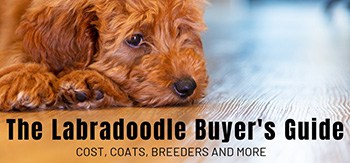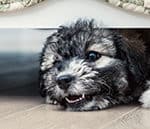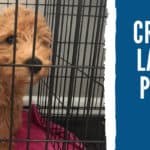Unlike many dog breeds that are known for a specific type of coat, Labradoodles are both known for and very popular for their different types of coats!
There are 3 types with their own characteristics.
Their coats come in a variety of colors, something we’ll also discuss, so you can be fully informed and know what to look for when finding your Labradoodle pup.
What are the different types of Labradoodle puppy coats? Labradoodle puppy coats may be one of three types: Fleece, Wool or Hair. Potential Labradoodle puppy owners not only can have a choice in what type of coated Labradoodle they want but also have various color choices from which to choose. Knowing a little about each coat type can make it easier for Labradoodle lovers to choose the coat that appeals best to them and their lifestyle.
- Fleece – This soft coat feels like angora
- Wool – Looks and feels like a poodle
- Hair – More similar to the Labrador Retriever’s coat
Deciding on which type of coat you would prefer is only one small part of welcoming a new puppy into your life.
Raising the cute little ball of fur takes some work, but is well worth it.
If you’re serious about getting a Labradoodle, you want to learn all you can about the breed, such as:
- Temperament and behavior.
- Exercise and mental stimulation.
- Socialization.
- Common health issues.
- Grooming requirements.
- Housebreaking and training.
- Recommended toys, tools, and supplies.
We cover all this and more as well as provide practical advice to help you raise the best puppy ever in our latest guidebook, The Owner’s Guide To The Perfect Labradoodle.
It’s a must-have filled with all you’ll need to know from puppyhood through adulthood.
Now, let’s take a closer look at each coat type to see which one sounds ideal to you.
As an owner of 2 Labradoodles myself, I know how tough it can be to find good information. In the 60+ pages of this book, I share the information, resources, and breed-specific tips I wish I’d had from the start. You will save you time, money, and loads of frustration…take my word for it!
What Characteristics Does Each Coat Type Have?
FLEECE COAT:
The fleece-textured coat is the coat most preferred by Labradoodle owners. The fleece coats are wavy but can also be tightly curled.
It has a soft silk-like feel to it and is easier to maintain than the wool coat. It can have a soft spiraling curl or a straight wavy appearance.
It’s very easy to manage and is said to be allergy friendly. If they do shed, it’s not very much.
WOOL COAT:
You can generally identify the wool coat by its feel rather than its look. It’s very similar to a poodle’s coat in that it’s soft and curly.
The fact that they do not shed makes them very popular choices for individuals who suffer from asthma and allergies.
The wool coat is the most sought after for those looking for hypoallergenic allergy-free dogs. Wool coats are curly when they’re short and wavy when left to grow.
HAIR COAT:
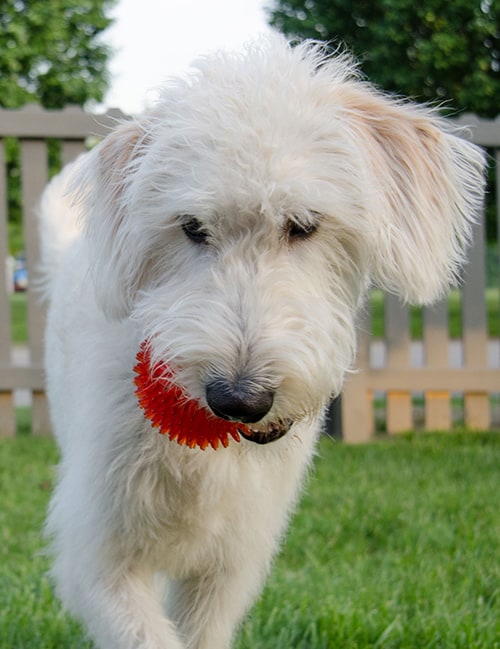
The hair coat is often found in generational dogs. It’s not generally the dog for someone looking for a dog with non-shedding qualities.
The hair coat is commonly seen in first-generation Labradoodles, the litter produced by pairing a Poodle and Labrador Retriever.
Common Coat Colors
The Labradoodle Coats come in various colors.
- Black
- Chocolate
- Red
- White
- Silver
- Cream
- Golden/Apricot
Have you ever wondered how their coat colors are determined? They get their coat colors from their parent.
Whatever coat color they end up with is the result of either a dominant or a recessive gene. Sound confusing?
It’s not as complicated as it sounds because they get their coat color in much the same way as humans get their eye colors.
Every Labradoodle puppy has two coat-color genes. They get one from each parent. The pup’s coat color is determined by how the two genes interact with each other.
Dominant genes are stronger than recessive genes. In order to have a recessive gene stronger, you would need two recessive genes – one from each parent.
The actual genes are more important than the color.
For instance, you may think that a black male and a black female would have a black puppy, but that may not be the case.
The puppy can be brown if both of the black parents had a brown recessive gene. Since their coats were black, their second gene, the dominant gene, would have been black.
Some colors, like black and red are dominant genes while brown and silver tend to be recessive genes.
Although it sounds complicated, it’s not complicated to experienced breeders who study and research genetics and breeding.
Some breeders are very dedicated to creating Labradoodles of certain coat color.
Grooming Requirements & Differences For Each Coat
HAIR COAT GROOMING:
The Labradoodle with a hair coat will shed even if it’s brushed regularly.
Owners may want to brush/comb them more frequently to decrease the amount of hair all over their house.
This dog should not have its body shaved. If it does require a haircut, a simple trimming with scissors is all that’s required.
Hair coat may be wavy, scruffy, or feathery, which can also determine the combing/brushing regimen.
What type of brush should you use? All Doodle dogs, regardless of coat type, will benefit from a slicker brush.
I found the one I use on Amazon and love it because it’s perfect for everyday use – gets the job done without being too harsh on the coat.
Best of all, it’s practically self-cleaning. Simply push a button, and hair trapped in the brush just falls out.
As far as combs are concerned, a dual-purpose steel comb, like this one, is ideal.
One side has thin, closely spaced teeth for detail work around the face and legs, and the other side has thicker, more widely spaced teeth for whole-body combing.
FLEECE COAT GROOMING:
The fleece-coated Labradoodle may have a coat of normal fleece or microfine fleece.
It’s considered an asthma and allergy-friendly dog that should be combed/brushed thoroughly and regularly to keep it that way.
The normal fleece should be brushed 2-3 times per week and trimmed a 3-4 times a year (possibly more depending on the desired look).
The super-soft microfine fleeced dog should be brushed regularly to prevent it from matting and to keep its asthma and allergy-friendly attributes.
A coat that gets longer than 3 inches becomes more difficult to properly maintain.
WOOL COAT GROOMING:
The wool coat comes in original wool and a cotton wool version.
The original wool, which is soft like a lamb, needs to be brushed or combed thoroughly at least once a week and trimmed three or four times a year.
The cotton wool coat has a softer texture than the original and is super dense. It’s the most successful in terms of being allergy friendly.
It requires a thorough brushing at least once a week and a haircut four times a year.
You’ll find a complete list of recommended grooming tools, including the clippers we love to use, in our Grooming Supply Guide.
You can bathe all Labradoodles as often as every week or as seldom as once every three months depending on how much time the dog spends outside.
Be sure to use a high-quality shampoo so their coat stays healthy.
This soap-free shampoo is our favorite hands down. It smells fabulous and does a super job of gently cleansing the coat without drying out the skin.
The hair-coated Labradoodle generally needs the most frequent bathing to avoid odors.
Any Drawbacks From Each Coat Type?
Labradoodle are adorable dogs regardless of their coat type. However, some coat types have advantages while others pose disadvantages.
Hair coats are the easiest to maintain, whereas wool coats require combing once or twice a week. One drawback to the hair coated Labradoodle is that they tend to shed.
HAIR: Again, easier to maintain but tends to shed.
WOOL: Because wool coats are denser, it’s going to be more time consuming to comb through the entire coat.
Failure to comb all the way through the hair will result in it becoming matted.
FLEECE: Fleece coats have a soft feel to them that’s accomplished by frequent combing/brushing. It wouldn’t hurt to comb their coat a few times a week.
Like the wool coat, the fleece coat must be thoroughly combed to prevent matting. This is especially important when they are shedding their puppy coat.
With both the wool and the fleece coats, it’s important also to comb all the way through their hair before allowing the coat to get wet or it’ll be a matted mess.
Even if you keep the hair short, it will still need to be combed frequently.
Regardless of the coat type, it’s important that they be combed all the way through to the skin.
Many owners don’t know this and simply comb the top layer of the coat, thinking they’re doing a great job.
Come to find out, the coat closest to the skin has started to form mats. Mats are painful for the pup and can be avoided with regular and proper brushing.
Does The Dog’s Generation Have An Impact On The Coat?
The dog’s generation has an impact on many of the Labradoodle’s characteristics, including the coat.
In fact, experienced breeders deliberately breed one generation to another generation just to bring out certain qualities.
Using the knowledge of genetics and correct usage of dominant and recessive genes, breeders can breed specific dogs to get desirable colors.
Breeders can also use generational breeding to get different coat types, but it’s not an exact science. In generational breeding, you have F1, F2, F3, and multi-generational breeding.
We explain these breedings more fully and share whether or not there are advantages in opting for a multi-generational Labradoodle in this article.
With experience and research, breeders can create Labradoodles with a certain coat type.
When you mix two purebred dogs of the same breed with the same coat type, your chances of getting the same kind of pups are good.
In the designer breeding world of Labradoodles, you’re mixing a straight-haired Labrador Retriever with a curly-haired Poodle, so how do you really know what you’re getting with puppies?
Here is where the F generation breeding comes into play, and the generation chart looks like this.
- F1 or First Cross Generation
- F1b or Back Cross Generation
- F2 Generation
- F2b Generation
- F3 Generation
- Multi-Generation
When you mix a Labrador Retriever with a Poodle, the pups are 50% Lab and 50% Poodle. They’re also called F1 or First Cross Generation.
Breeders can mix an F1 with another F1 to get an F2, but it’s seldom done because with crossbreeds they don’t know what they’ll get.
They generally will take an F1 and mix it with an F2 or F3 in an attempt to fine-tune it and bring out certain attributes and characteristics.
Related Questions:
Do Labradoodles have dander in their fur?
Experts on dogs and allergies state that all dogs have dander and allergens, and that there is no such thing as a hypoallergenic dog.
However, Labradoodles have the least amount of dander, and many allergy sufferers have found success having a Labradoodle as a dog.
How often do Labradoodles need to be brushed?
Labradoodles should be brushed anywhere from daily to once a week or so. The amount of brushing depends on the type of coat as well as the type of activities the dog does on a daily basis.
That’s A Wrap
Reading and hearing about the grooming requirements may make it sound like the Labradoodle dog is a high-maintenance pet requiring lots of work.
However, the joy this loving, loyal, and intelligent pet provides makes it more than worthwhile.
The most important thing you can do for your dog is to become as knowledgeable as possible.
Grab your copy of The Owner’s Guide To The Perfect Labradoodle today to learn how to not just care for your new puppy but to ensure that he’s off to the best possible start in life.


